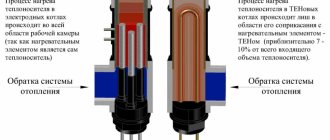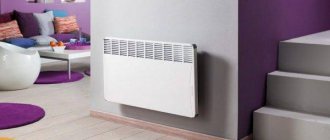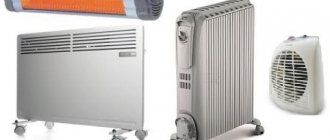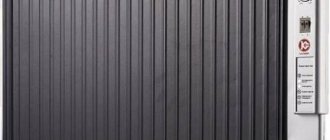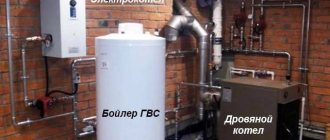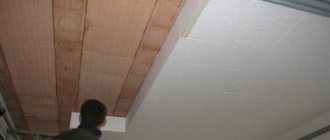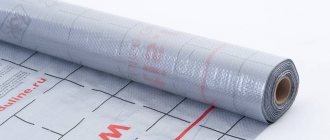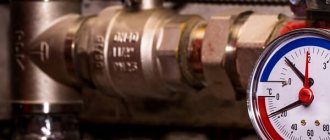Ensuring an optimal microclimate at home or at work is a very important task. The required indoor air temperature provides comfortable conditions for both work and rest. But choosing a heater is not an easy task. This is due to the variety of models on the market. The right approach to evaluating equipment will guarantee a purchase you won’t regret. To find the best convectors for your home or office, you need to identify the main criteria for choosing a device.
You shouldn’t save money on buying a convector
Operating principle and classification
The design of the device for generating heat is quite simple: a housing, air ducts, a heating element, and connection equipment. The principle of operation is also straightforward: cold air from the environment enters the device. With the help of additional devices, it is heated and released out through a hole at the top of the device.
To save energy and maintain optimal temperature, room heaters are equipped with temperature sensors. The main advantage of convectors over similar heat sources is safety. The temperature on the device body remains no higher than +60°C.
In this video you will learn how to choose a heater:
Classification of convectors:
- by mode of action (water, electric, gas);
- by type of fastening (floor, wall, universal);
- according to the design of the heating element (monolith, heating element, needle).
See also: installation of convectors built into the floor.
Water convectors are suitable for installation in both autonomous and central heating systems. It is not advisable to place them in rooms with high wall heights. If there is forced air circulation in the room, the device will be ineffective.
The advantage of gas convectors compared to water heaters is their independence of operation from low temperatures. The disadvantages include the significant dimensions of the installations and increased explosion hazard. The best choice for heating apartments and cottages is electric convectors.
Convectors differ, at a minimum, in the method of mounting
Design and principle of operation of the equipment
Having all the necessary information about devices with the convector heating principle, making a purchase will be much easier.
The main structural elements of the device are the housing, the heating element (heat exchanger) and the thermostat with a regulator located on the external panel. Many convectors are “equipped” with various additional features to increase the comfort and safety of device operation.
A convector heater is a practical device for heating an apartment, private house or cottage, with high efficiency and reliability.
The functioning of the devices is based on the process of natural air circulation - convection. Cold air enters the convector body, where, upon contact with the heating element, it quickly heats up and rushes upward.
Basic physics: warm air is lighter than cold air. Having cooled down, it falls down and enters the heater again - and the cycle repeats.
Thus, thanks to convection, warm air masses constantly circulate in the rooms and a comfortable temperature is maintained. This operating principle allows the equipment to heat the air not only efficiently, but also as uniformly as possible.
The statement that convectors dry the air is a common misconception. The devices heat the air, but the amount of moisture in it does not change much
Main characteristics
Since a convector is a thing that is purchased for long-term use, you need to approach the purchase responsibly. Heaters are evaluated according to various characteristics. You can quickly navigate when choosing a device by highlighting its most important parameters.
Indicators you should pay attention to before purchasing:
- method of mounting the device;
- power consumption;
- thermostat type;
- type of heater;
- security.
Depending on their location, convectors come in wall-mounted, floor-mounted and universal types. When purchasing a wall heater, you need to check whether parts for mounting it are supplied with the device. Some models do not have them and must be purchased separately. The advantage of this type of convectors is that they save space: they do not take up additional space in the room, which is essential for rooms and apartments with a small area.
Don’t forget to look at the power consumption of the convector when purchasing it
Floor heaters are equipped with legs or wheels. Their advantage is mobility. By moving them, you can achieve the required temperature in all hard-to-reach areas of the room.
The most practical are universal type convectors. They can be installed on the floor or hung on the wall. When purchasing, you should check if the package includes wheels or legs: sometimes you have to buy them separately.
One of the decisive factors when choosing a heater is its power. If you purchase a device with a low value, it will be impossible to achieve the optimal temperature in the room. Excessive power is the key to an unreasonably high cost of the device.
It is necessary to take into account the purpose of the convector (sole source of heat or auxiliary). If it is needed in an apartment as an additional heater, then one kilowatt of the device’s power will be enough for a room of 20 square meters. In the absence of main heating, you should choose microclimate equipment with a high power value.
Will the convector be an additional heater or the main one?
Convector thermostats can be of two types:
- mechanical;
- electronic.
When choosing a cheap heating device that will rarely be used, it is worth considering models with mechanical temperature control. They are distinguished by their simplicity, reliability and long service life.
Heating devices with an electronic thermostat ensure that the temperature is maintained within a more precise range. This allows you not to waste extra energy when heating, saving energy resources, and, consequently, finances. Their disadvantage is the higher cost of the convector when purchasing or repairing due to its complex structure. The choice of devices with an electronic thermostat is appropriate if long-term operation is planned during the heating season.
According to their design, the heating elements of convectors can be:
- open;
- closed;
- sealed.
Open type heaters are more repairable, but less fireproof and often break down. During operation, they significantly reduce the oxygen content in the air, which negatively affects people in the room, especially the elderly and infants.
In a closed version, the spiral is located in a protected metal casing. Such convector heaters are less susceptible to breakdowns and do not have a harmful effect on the human body, since they do not dry the air during operation.
The best option would be heaters with a spiral sealed in a hermetic frame without air access. Such convectors are called monolithic. They are the most reliable, have good heat dissipation, and can be used in high humidity environments. Their high cost is fully compensated by their long service life, safety, operational stability and minimal breakdowns.
The device provides several types of protection:
- from injuries;
- from electric shock;
- from using the device by children;
- from overheating and freezing.
Types of convector heaters
Convectors for heating rooms can be part of water heating, or can be separate heating devices. Before choosing a convector, you need to familiarize yourself with their properties and features, at least in general terms. This way the choice will be conscious and, most likely, you will make it correctly.
What is good about convection heating - you can add heat sources or change their position at any time
For water heating
Convectors for water heating differ from radiators in having a much larger heat-emitting surface. Typically, additional plates (ribs) are attached to the coolant pipe. These fins also heat up, and the passing air takes away this heat. Due to this, heating is accelerated. It is the large area of the heat exchanger that distinguishes home heating with convectors from radiator heating, although this division is largely arbitrary.
For a more attractive appearance, the structure made of a pipe with plates is covered with a metal casing or decorative grille. The device is not very attractive in appearance, but due to the ribs and convection it effectively transfers heat.
According to the installation method, there are the following types of water convectors for heating a house or apartment:
- Built into the floor. An ideal option if you need to heat a panoramic window (also called French glazing), glass doors leading to a terrace, balcony, or garden. The decorative grille covering the device is at the same level with the floor covering, the air flow is directed towards the glass, preventing it from freezing. Disadvantages - difficulty of installation. This can only be done at the stage of major overhaul. Moreover, you will have to either make a recess under the body, which is not always possible, or raise the floor. Both solutions are expensive.
Floor-mounted convectors for water heating - Wall-mounted. One type is metal radiators. In them, the convection component of heat transfer is very high, although they are called radiators. A cheaper option compared to any other radiators, but also more often subject to replacement (black metal is used, but it quickly deteriorates).
Metal radiators operate on the principle of convection - Floor radiators. These models can stand not only against the wall. These convector models can be chosen if you need to heat a glass wall or a large window from the floor to the ceiling. They are also installed if the load-bearing capacity of the material from which the wall is made cannot withstand large static loads (plasterboard partitions, for example). Externally they differ little from wall-mounted ones, except that they stand on legs. There are designer models that can even be in the form of a bench or table.
Floor-mounted models are often low in height - Heating baseboard. This is one of the varieties of water convectors, which is characterized by its small height - up to 12-15 cm and depth - about 5 cm. It consists of copper pipes with fins, covered with special plastic casings that are very reminiscent of baseboards. The system is assembled from small sections connected to each other by pipes. It is mounted at the junction of the floor and walls along the perimeter of the room - exactly where the baseboard is usually located. Because of its appearance it is called “baseboard heating”. If you do not want heating with convectors to spoil the design, pay attention to baseboard convectors.
- Water warm baseboard
In our country, you rarely see convectors in a water heating system. We are accustomed to trusting more reliable metals: cast iron, stainless steel, etc. Although, if desired, you can also find copper models that will last a long time. But here the price stops us - it’s too high. And there is a difference in sensations - heating a house with convectors is not comfortable for everyone, as it creates a feeling of draft.
Electric convectors
If there is no desire or opportunity to invest a lot of money in a water heating system, heating the house with convectors can be done on the basis of electric models. These are independent heating devices that can be either an additional or the main source of heat. There are electric convectors with different installation methods:
- Wall-mounted: installed under the window to cut off the cold that comes from the glass, traditionally have the shape of a rectangle, hung on several fasteners screwed into the wall or screwed to it;
- hung on any free section of the wall;
- They are mounted under the ceiling, often similar to the indoor unit of an air conditioner, and have blinds to change the direction of the air flow, which are controlled from a remote control.
For heating with electric convectors, you can choose models for any part of the wall
Wheels make it easier to move around
Heating a house with convectors powered by electricity is good because it does not require serious installation. These devices weigh little and do not create a large load on the walls. You only need two or three hooks (depending on the size) on which they are hung and a nearby socket. And that’s it, you can turn it on and warm up. Another plus is that the failure of one of the elements (except for the power supply, of course) does not harm all the others. Replacing a non-working convector is a matter of a couple of minutes if you have one in stock, or a couple of hours if you need to go buy one.
Well, the disadvantages of electric convectors are as follows:
- No electricity, no heating. No options. At least light a fire in the house (or better yet, make an emergency power supply system, but this is a big expense).
- Heating a house with convectors has low thermal inertia. This allows you to quickly start warming up, but as soon as the convectors turn off, the house or apartment begins to cool down.
- Electricity is the most expensive energy source, and heating with convectors is also not cheap. For example, to warm up a house of 100 sq.m. in Central Russia, from 1000 to 1400 kW per month is consumed. The exact consumption depends on average monthly temperatures and the degree of insulation of the house, but the estimated cost is easy to calculate from these data. Even taking into account night rates (if there are any), this amounts to a lot.
Heating a house with convective heaters is reliable - the devices are simple, there is nothing to break - Heating a home with all-electric convectors requires a lot of dedicated power, and not everyone has that luxury.
In general, heating a house with convectors in places where power outages are rare is a good option that does not require large expenses for the design and installation of heaters. But it is expensive in terms of monthly expenses.
Gas convector heaters
If you don’t know how to make heating your home with convectors economical, consider gas convectors. These are small devices that can be powered by natural or liquefied gas. Gas is the cheapest fuel today, so heating with gas convectors is one of the most economical.
It’s easiest to make heating with parapet-type convectors
The design of gas convectors is simple and efficient, with an average efficiency of 85%. The gas is burned in a heat exchanger (steel or cast iron), the heat is distributed either through natural processes or through the operation of a built-in fan. Combustion products are discharged through a pipe to the street. According to the method of gas removal, this equipment is:
- With coaxial pipe (pipe in pipe). Also called parapet type. Can be mounted on any external wall. To install, you need to make a hole in the wall of a suitable diameter for the chimney. The air required for the combustion process enters the burner/heat exchanger through the outer coaxial pipe, and combustion products exit through the inner pipe.
- Fireplace type. This type of gas convectors can be installed near the chimney. Combustion products are discharged through a traditional chimney design. Combustion air is taken from the room in which the equipment is installed, so supply ventilation is necessary.
The main difference between a convector with a coaxial pipe and a fireplace type convector is the combustion product removal system
If you want to heat your home with gas convectors, you need to decide on the type of smoke exhaust. Less hassle when installing parapet models. But, when working in cold weather, the coaxial cable often freezes, so that the air intake and gas removal stops, which leads to the heating stopping (the automatic system is activated). If this happens during the day, it’s not a problem to clean the pipe from ice, but going outside at night in the cold is not a very pleasant idea.
Another disadvantage is that in a strong wind, too much air flow enters the coaxial, which can blow out the burner flame. This phenomenon is quite successfully combated with the help of protective grilles, but still, in a certain direction, the wind sometimes extinguishes the flame.
Heat exchanger in which gas burns and heats the air
There are more difficulties with installing a fireplace-type gas convector: you need to install a chimney and ensure a flow of air for combustion. But such devices operate more stable and are not afraid of any frost. The downside is that if you need to heat the whole house with convectors and install a unit in each room, you will have to install a chimney for each. Or think through the system so that the multi-channel chimney is in the center, and fireplace convectors are connected to it. This is also not at all easy, but there are fewer costs and hassles. In any case, heating a house with gas convectors is much more economical than with electric models.
Additional functions
In convectors with electronic control, manufacturers offer a number of additional modes. Before purchasing, you should make sure whether they are really necessary. The anti-freeze function will allow you to maintain the minimum temperature in the room within +5...+7°C in the absence of the owners. At the same time, the bill for consumed energy is small, since an empty home will not overheat in vain.
Programming operating modes allows you to set the necessary parameters at different times of the day, which will significantly save energy resources and fees.
The remote control function makes it easier for disabled and elderly people to operate the device. Air ionization is useful for people who have to stay indoors for a long time, as well as for asthmatics and allergy sufferers.
It should be taken into account that auxiliary functions provide additional comfort when using the device, but at the same time increase its cost.
How to choose a model
There are many different types of convectors. Some run on electricity, others use hot water for heating. The best convectors are electric and gas.
The convector can be selected according to the following parameters:
- Power. This parameter should be of particular concern to the buyer. It is important to consider the area of the room, gas or electricity consumption. It is recommended to adhere to the formula: heating 1 m2 requires 100 W of energy. For a room of 10 m2, a 1 kW device will be sufficient. This is only an estimated calculation, it does not take into account such subtleties: the density of walls, windows. If such conditions exist, it is worth adding another 50 W of energy.
- Room type. The temperature in each room varies greatly. In a room of 10 m2 it would be great to install a convector designed to be a couple of square meters larger. In offices, on the contrary, it is worth installing a less powerful heater. For the living room you need to purchase a device with an equal area. It is important to choose a convection heater for your home based on the type of room; you should always remember this.
- Type of fastening. Most convectors are fixed to the wall or floor. Wall installation will help save space on the floor, and also make the device as safe as possible for the inhabitants of the house. And the floor heater is easy to move. You can simply pick it up and move it wherever you need it without any effort. For an apartment, it is best to choose a convector from this category.
On a note! To maintain the heating level of the room, thermostats are installed in the convector.
There are two types: mechanical and electronic convectors. Mechanical is now considered by many to be obsolete, but it costs less and is more reliable. When choosing such a device, do not forget about safety. Any device is dangerous. Electric convectors are considered harmless, but increased power may behave poorly with old wiring. It is important to ensure that the following functions are available: protection against overheating, short circuits and water ingress.
Rating of electric convectors
The most popular heating devices are those that consume electrical energy. This is not surprising, since this type of heater has quite a lot of advantages:
- ensuring the same temperature in all points of the room;
- noiselessness;
- work without accumulation of dust and unpleasant odors;
- during operation, humidity does not decrease, since oxygen is not burned;
- high heating rate;
- energy saving;
- small dimensions;
- ease of use and reliability.
There is no clear answer to the question of which electric convector is better. Products from such well-known brands as Noirot, Neoclima, Electrolux, Ballu, Timberk have been tested by many users and time. Therefore, models from these companies often take first place in ratings of the best electric convectors. Every day new manufacturers of household microclimate appliances appear on the market. The cost of the products they offer is slightly less due to the unknown, but it is difficult to judge their quality and level of reliability.
Electric convectors of the new generation are distinguished by their stylish appearance, the presence of a liquid crystal display, and an energy-saving operating mode. In order to objectively evaluate certain heating equipment, you should take into account the location of its installation.
Microclimate devices for home
For a home with an autonomous heating system, in which people are constantly present, convectors are selected with low power, since they mainly serve as additional heat sources.
Top 5 best electric heating convectors for the home.
| Place in the ranking | Company name, model | Advantages | Flaws |
| 1 | Ballu BEC/EZER-1000 | High level of fire safety due to overheating and tip-over protection. Timer up to 24 hours. Silence. Possibility of air ionization. | Unsteadiness due to errors in the design of the legs |
| 2 | Timberk TEC. PS1 LE 1500 IN | High heat transfer due to the increased area of the heating element. Two operating modes. Timer. Ionizer. | Clicking sounds when automatically shifting |
| 3 | Stiebel Eltron CNS 150 S | Silence. Possibility of use as the main type of heating. | High price |
| 4 | Electrolux ECH/AG-1500 EF | Reaching operating temperature in 75 seconds. Moisture protection. Self-diagnosis functions and memory of specified settings. | In reality, the heating area is smaller than that indicated in the device passport |
| 5 | Noirot Spot E-3 1000 | Quiet operation. Protection against overheating and moisture. | The package does not include wheels for moving |
Heating a country house
When wondering which convector to choose for your dacha, you should take into account that there is no central heating and heating is only needed for a few days in the winter or cold autumn-spring period. Therefore, when compiling a rating of convectors for a summer residence, the main criterion is the selection of high-power equipment, preferably with an anti-freeze function. One kilowatt of device power will be enough for only 10 square meters of heated space.
Five best electric convectors for summer cottages
| Place in the ranking | Name | Advantages | Flaws |
| 1 | Nobo C4F20 XSC Viking | Large heating area. Operating temperature is reached in 1 minute. Economical | High price |
| 2 | Hyundai H-HV14-20-UI540 | Optimal price. Possibility of heating a large area. | Wheels must be purchased separately |
| 3 | Noirot Spot E-3 2000 | Quickly reaches operating temperature. Frost protection function. | Short power cord. Wheel legs are not included in the package. |
| 4 | Ballu ENZO BEC/EZMR-2000 | Universal installation. Air ionization. Saving settings after power off. Child lock. | In nominal operating mode, the actual heat transfer is less than that declared by the manufacturer |
| 5 | Electrolux ECH/AG2-2000 MF | Air purification and filtration functions. Significant service life. Ability to work at high humidity. | No instrument indicator lamp |
Despite the numerous advantages of electric convectors, their disadvantages are dependence on an uninterrupted supply of electricity and the inability to accumulate heat. Therefore, the ideal option is to use them in combination with other heating methods.
Choosing convector heating for a private home
Heating in a wooden house with convectors running on liquid coolant is the best option because it ensures fire safety. Water heating is also suitable for heating multi-storey buildings and several rooms at once. Since all radiators are connected to the same wiring, all rooms can be maintained at the same temperature. This cannot be achieved with gas and electric convectors.
Electric convectors are suitable for heating one residential or commercial space. These devices can be used to heat a garage, greenhouse or balcony. It is not profitable to use electric convectors for heating several rooms, because in addition to purchasing a unit for each individual room, there will be significant energy costs.
On a note! Autonomous water convector heating is chosen if it is possible to install a gas or solid fuel boiler.
Electric convectors can be used to heat small houses for seasonal use. This way you will be protected from freezing of the coolant during the cold season when the owners are absent from the house. Gas and electric convectors are not suitable for heating a large house. A significant disadvantage of gas units is that for each device you need to install a separate chimney and make a hole in the wall of the house. In this case, it is much more profitable to install a gas boiler and organize water heating.
Pros and cons of convector heating
The advantages of convector heating in a private house are as follows:
- Individual devices can be used to heat all rooms, regardless of their purpose. Water convectors are used to maintain a comfortable temperature in several living rooms, and electric gas units are more suitable for utility rooms and seasonal buildings.
- Water radiators and electric convectors do not burn oxygen. This statement is true only for gas units with a closed combustion chamber.
- Convectors maintain a comfortable temperature in the room without changing the air characteristics, which is important for people’s well-being.
- There are devices on sale with different sizes and characteristics, so each buyer can choose a suitable convector.
- The main advantage of such devices is their visual appeal. Thanks to this, they fit well into the interior of the rooms.
- Convector appliances heat the air in the room quite efficiently and quickly.
- To reduce heat loss, a convector-type device is installed under the windows to form a thermal curtain.
- The device can be installed on the floor or hung on the wall. Mobile convectors can be moved from place to place.
- There are many types of water convectors - baseboard devices, in-floor units, devices hung on walls.
The main disadvantage of convector heating is the excessive dryness of the air in the room. Active air circulation contributes to the same movement of dust in the room, which negatively affects the health of young children and allergy sufferers. Another disadvantage is that the difference between the air temperature at the bottom and at the top of the room is significant.
Another disadvantage of convector appliances is that they cannot be used for heating high rooms. This is due to the fact that the heated air will be high under the ceiling, and it will be cold in the area where the person is staying.
